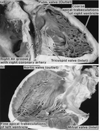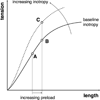Methods for measuring right ventricular function and hemodynamic coupling with the pulmonary vasculature
- PMID: 23423705
- PMCID: PMC3679286
- DOI: 10.1007/s10439-013-0752-3
Methods for measuring right ventricular function and hemodynamic coupling with the pulmonary vasculature
Abstract
The right ventricle (RV) is a pulsatile pump, the efficiency of which depends on proper hemodynamic coupling with the compliant pulmonary circulation. The RV and pulmonary circulation exhibit structural and functional differences with the more extensively investigated left ventricle (LV) and systemic circulation. In light of these differences, metrics of LV function and efficiency of coupling to the systemic circulation cannot be used without modification to characterize RV function and efficiency of coupling to the pulmonary circulation. In this article, we review RV physiology and mechanics, established and novel methods for measuring RV function and hemodynamic coupling, and findings from application of these methods to RV function and coupling changes with pulmonary hypertension. We especially focus on non-invasive measurements, as these may represent the future for clinical monitoring of disease progression and the effect of drug therapies.
Figures






References
-
- Abel FL. Fourier Analysis of Left Ventricular Performance Evaluation of Impedance Matching. Circ Res. 1971;28:119–135. - PubMed
-
- Abraham TP, Dimaano VL, Liang H-Y. Role of tissue Doppler and strain echocardiography in current clinical practice. Circulation. 2007;116:2597–2609. - PubMed
-
- Amundsen BH, et al. Noninvasive myocardial strain measurement by speckle tracking echocardiography: validation against sonomicrometry and tagged magnetic resonance imaging. J Am Coll Cardiol. 2006;47:789–793. - PubMed
-
- Anderson RH, Ho SY. What is a ventricle? Ann Thorac Surg. 1998;66:616–620. - PubMed
-
- Antoni ML, et al. Prognostic value of right ventricular function in patients after acute myocardial infarction treated with primary percutaneous coronary intervention. Circ Cardiovasc Imaging. 2010;3:264–271. - PubMed
Publication types
MeSH terms
Grants and funding
LinkOut - more resources
Full Text Sources
Other Literature Sources

